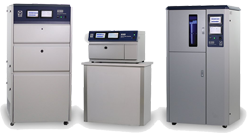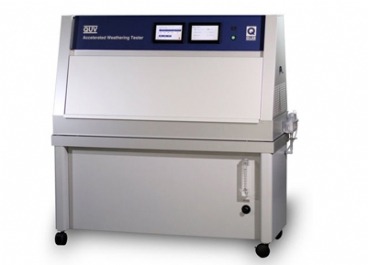耐候性试验
Weathering Testing
咨询热线
18566398802ASTM G154-12
ASTM G154-12标准介绍
使用荧光紫外线设备对非金属材料进行曝露的测试方法
本测试方法是使用荧光紫外灯和冷凝装置进行曝露测试的基本原则和操作程序,旨在再现材料曝露在阳光下(直接或透过窗玻璃)和曝露在湿气中(雨水或露水)发生的老化效果。 这种做法限制于获取测量和控制的条件和曝光程序的方法,不能指定最适合要测试的材料的曝光条件。
附:ASTM G154 -12英文版本(摘抄)
Significance and Use
5.1 The use of this apparatus is intended to induce property changes associated with the end use conditions, including the effects of the UV portion of sunlight, moisture, and heat. These exposures may include a means to introduce moisture to the test specimen. Exposures are not intended to simulate the deterioration caused by localized weather phenomena, such as atmospheric pollution, biological attack, and saltwater exposure. Alternatively, the exposure may simulate the effects of sunlight through window glass. Typically, these exposures would include moisture in the form of condensing humidity.
Note 2—Caution: Refer to Practice G151 for full cautionary guidance applicable to all laboratory weathering devices.
5.2 Variation in results may be expected when operating conditions are varied within the accepted limits of this practice. Therefore, no reference shall be made to results from the use of this practice unless accompanied by a report detailing the specific operating conditions in conformance with the Section 10.
5.2.1 It is recommended that a similar material of known performance (a control) be exposed simultaneously with the test specimen to provide a standard for comparative purposes. It is recommended that at least three replicates of each material evaluated be exposed in each test to allow for statistical evaluation of results.
1. Scope
1.1 This practice covers the basic principles and operating procedures for using fluorescent UV light, and water apparatus intended to reproduce the weathering effects that occur when materials are exposed to sunlight (either direct or through window glass) and moisture as rain or dew in actual usage. This practice is limited to the procedures for obtaining, measuring, and controlling conditions of exposure. A number of exposure procedures are listed in an appendix; however, this practice does not specify the exposure conditions best suited for the material to be tested.
Note 1—Practice G151 describes performance criteria for all exposure devices that use laboratory light sources. This practice replaces Practice G53, which describes very specific designs for devices used for fluorescent UV exposures. The apparatus described in Practice G53 is covered by this practice.
1.2 Test specimens are exposed to fluorescent UV light under controlled environmental conditions. Different types of fluorescent UV light sources are described.
1.3 Specimen preparation and evaluation of the results are covered in ASTM methods or specifications for specific materials. General guidance is given in Practice G151 and ISO 4892-1. More specific information about methods for determining the change in properties after exposure and reporting these results is described in ISO 4582.
1.4 The values stated in SI units are to be regarded as the standard.
1.5 This standard does not purport to address all of the safety concerns, if any, associated with its use. It is the responsibility of the user of this standard to establish appropriate safety and health practices and determine the applicability of regulatory limitations prior to use.
1.6 This standard is technically similar to ISO 4892-3 and ISO DIS 11507.
Referenced ASTM Standards
D3980 Practice for Interlaboratory Testing of Paint and Related Materials
E691 Practice for Conducting an Interlaboratory Study to Determine the Precision of a Test Method
G53 Practice for Operating Light-and Water-Exposure Apparatus (Fluorescent UV-Condensation Type) for Exposure of Nonmetallic Materials
G113 Terminology Relating to Natural and Artificial Weathering Tests of Nonmetallic Materials
G151 Practice for Exposing Nonmetallic Materials in Accelerated Test Devices that Use Laboratory Light Sources
CIE Standard
CIE-Publ.No.85: Recommendations for the Integrated Irradiance and the Spectral Distribution of Simulated Solar Radiation for Testing Purposes Available from Secretary, U.S. National Committee, CIE, National Institute of Standards and Technology (NIST), Gaithersburg, MD 20899.
ISO Standards
ISO 4582 Plastics--Determination of the Changes of Colour and Variations in Properties After Exposure to Daylight Under Glass, Natural Weathering or Artificial Light Available from American National Standards Institute (ANSI), 25 W. 43rd St., 4th Floor, New York, NY 10036, http://www.ansi.org.
ISO 4892-1 Plastics--Methods of Exposure to Laboratory Light Sources, Part 1, Guidance
ISO 4892-3 Plastics--Methods of Exposure to Laboratory Light Sources, Part 3, Fluorescent UV lamps
ISODIS 11507 Paint and Varnishes--Exposure of Coatings to Artificial Weathering in Apparatus--Exposure to Fluorescent Ultraviolet and Condensation Apparatus
ASTM G154-06版本简介
1. Scope
1.1 This practice covers the basic principles and operating procedures for using fluorescent UV light, and water apparatus intended to reproduce the weathering effects that occur when materials are exposed to sunlight (either direct or through window glass) and moisture as rain or dew in actual usage. This practice is limited to the procedures for obtaining, measuring, and controlling conditions of exposure. A number of exposure procedures are listed in an appendix; however, this practice does not specify the exposure conditions best suited for the material to be tested.
Note 1
Practice G 151 describes performance criteria for all exposure devices that use laboratory light sources. This practice replaces Practice G 53, which describes very specific designs for devices used for fluorescent UV exposures. The apparatus described in Practice G 53 is covered by this practice.
1.2 Test specimens are exposed to fluorescent UV light under controlled environmental conditions. Different types of fluorescent UV light sources are described.
1.3 Specimen preparation and evaluation of the results are covered in ASTM methods or specifications for specific materials. General guidance is given in Practice G 151 and ISO 4892-1. More specific information about methods for determining the change in properties after exposure and reporting these results is described in ISO 4582.
1.4 The values stated in SI units are to be regarded as the standard.
This standard does not purport to address all of the safety concerns, if any, associated with its use. It is the responsibility of the user of this standard to establish appropriate safety and health practices and determine the applicability of regulatory limitations prior to use.
1.5 This standard is technically similar to ISO 4892-3 and ISO DIS 11507.
ASTM G154-04版本简介
1. Scope
1.1 This practice covers the basic principles and operating procedures for using fluorescent UV light, and water apparatus intended to reproduce the weathering effects that occur when materials are exposed to sunlight (either direct or through window glass) and moisture as rain or dew in actual usage. This practice is limited to the procedures for obtaining, measuring, and controlling conditions of exposure. A number of exposure procedures are listed in an appendix; however, this practice does not specify the exposure conditions best suited for the material to be tested.
Note 1—Practice G151 describes performance criteria for all exposure devices that use laboratory light sources. This practice replaces Practice G53, which describes very specific designs for devices used for fluorescent UV exposures. The apparatus described in Practice G53 is covered by this practice.
1.2 Test specimens are exposed to fluorescent UV light under controlled environmental conditions. Different types of fluorescent UV light sources are described.
1.3 Specimen preparation and evaluation of the results are covered in ASTM methods or specifications for specific materials. General guidance is given in Practice G151 and ISO 4892-1. More specific information about methods for determining the change in properties after exposure and reporting these results is described in ISO 4582.
1.4 The values stated in SI units are to be regarded as the standard.
1.5 This standard does not purport to address all of the safety concerns, if any, associated with its use. It is the responsibility of the user of this standard to establish appropriate safety and health practices and determine the applicability of regulatory limitations prior to use.
1.6 This standard is technically similar to ISO 4892-3 and ISO DIS 11507.
ASTM G154-00版本简介
1. Scope
1.1 This practice covers the basic principles and operating procedures for using fluorescent UV light, and water apparatus intended to reproduce the weathering effects that occur when materials are exposed to sunlight (either direct or through window glass) and moisture as rain or dew in actual usage. This practice is limited to the procedures for obtaining, measuring, and controlling conditions of exposure. A number of exposure procedures are listed in an appendix; however, this practice does not specify the exposure conditions best suited for the material to be tested.
Note 1—Practice G151 describes performance criteria for all exposure devices that use laboratory light sources. This practice replaces Practice G53, which describes very specific designs for devices used for fluorescent UV exposures. The apparatus described in Practice G53 is covered by this practice.
1.2 Test specimens are exposed to fluorescent UV light under controlled environmental conditions. Different types of fluorescent UV light sources are described.
1.3 Specimen preparation and evaluation of the results are covered in ASTM methods or specifications for specific materials. General guidance is given in Practice G151 and ISO 4892-1. More specific information about methods for determining the change in properties after exposure and reporting these results is described in ISO 4582.
1.4 The values stated in SI units are to be regarded as the standard.
1.5 This standard does not purport to address all of the safety concerns, if any, associated with its use. It is the responsibility of the user of this standard to establish appropriate safety and health practices and determine the applicability of regulatory limitations prior to use.
1.6 This standard is technically similar to ISO 4892-3 and ISO DIS 11507.
温馨提醒:本ASTM G154-12可能存在更新的版本,建议寻找ASTM G154-12的发行商确认。


 紫外线老化箱
紫外线老化箱 粤公网安备 44060402000067号
粤公网安备 44060402000067号